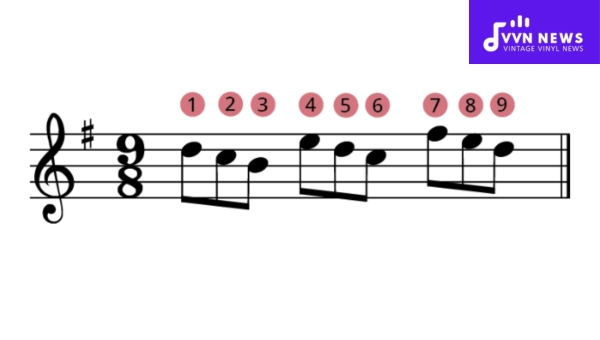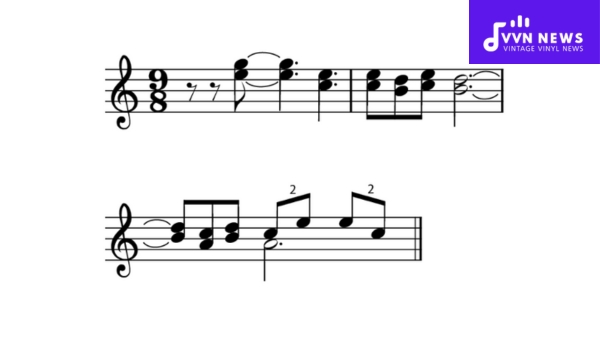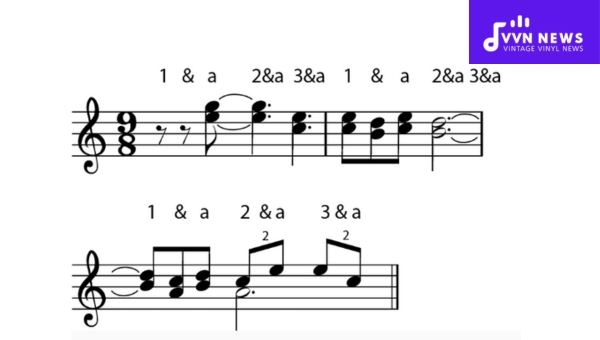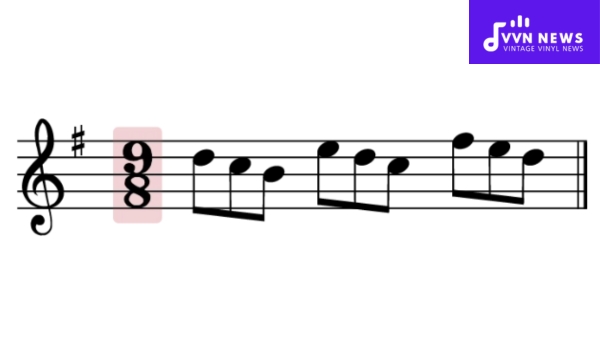Music, in all its complexity and vastness, has a profound way of speaking to our very human emotions. It stirs the soul, invokes memories, and has the power to transport us to different places or times.
One crucial ingredient that contributes immensely to the magic of music is the time signature. In this instance, we’ll focus on the intriguing time signature 9/8.
The time signature, also known as the meter signature, provides a fundamental framework for the rhythm of a piece of music.
A unique and less common time signature like 9/8 adds interest to any composition by giving an extra touch of unpredictability while maintaining an execution that is pleasing to the ear.
In essence, it’s like adding a dash of unexpected spice to your favorite recipe.
What’s the Concept of Time Signature 9/8?
In music, the time signature of 9/8 consists of nine eighth notes (quavers) per measure, divided into three groups of three.
This categorizes it as a compound triple meter—’compound’ because each beat can subdivide into three smaller units, and ‘triple’ because there are three beats per measure.
Though it shares similarities with simple triple times, like 3/4, the nine quavers in 9/8 bring a unique rhythmic feel—a lilting flow that can resemble a waltz with an extra skip.
Composers often utilize 9/8 to infuse songs with a sense of movement and grace, setting apart pieces with their distinct pulse.
Also Read: Harmony In Music [Enhance Your Compositions With These Tips]
What’s the counting method for Time Signature 9/8?
In 9/8, each bar consists of nine eighth notes. One might initially be inclined to count this as nine individual beats, but the beauty of 9/8 lies in its compound structure.

You’d count it as three groups of three eighth notes giving us a triplet feel.
Here’s a simple breakdown:
- Identify groups: Divide the nine eighth notes into three sets of three.
- Assign counts: Count each group as ‘1,2,3‘, making sure to emphasize the ‘1’. This indicates the first beat of each group.
- Counting out: Your counting for each bar will sound like ‘1-2-3, 4-5-6, 7-8-9′, accentuating the numbers in bold.
When put to practice, ensure a smooth, flowing rhythm between these accents.
Feel the emphasis naturally weave through the music as you maintain a steady beat and pace your counts to match the tempo set by a composer or conductor.
Why is 9/8 Considered a Compound, Triple Time Signature?
9/8 is a rhythmic pattern that musicians and enthusiasts often refer to as a compound, triple-time signature.
This may initially seem like a cryptic term, but it’s efficiently descriptive when you break it down.
In music theory, compound implies that each beat is divisible by three instead of the standard two. The ‘triple’ denotes three primary beats per measure.
A standard 9/8 meter divides the measure into three groups of three eighth notes, each group equivalent to a dotted quarter note.
Unlike simple time signatures, where the beat can be subdivided evenly into two parts, compound meters like 9/8, have subdivisions that are triples—hence “compound”.
The descriptor triple comes in because there are three beats, instead of two or four which are common in simple meters.
Thoroughly, it’s this grouping into threes at both the beat and subdivision levels that earn 9/8 its title as a compound, triple meter—an alluring time signature providing an expansive rhythmic canvas for composers and performers alike.
Also Read: F Sharp Minor Pentatonic Scale [How To Use In Your Compositions]
In what ways do 9/8 and 9/4 times differ?
Within the realm of rhythm and melody lies a critical distinction between various musical time signatures.

When we compare 9/8 and 9/4 times, it’s important to recognize how they influence the flow and feel of music.
Let’s dive into five key points that highlight their differences.
Pulse Grouping
9/8 is primarily a compound triple-time signature. This means it consists of three primary beats, each subdivided into three smaller beats (3×3).
In contrast, 9/4 time often manifests as a simple triple meter with three groups of three-quarter notes, making it feel significantly more ‘march-like’ as compared to the ‘waltz-like’ swaying rhythm of 9/8.
Note Value
Another prominent difference lies within their core note value. In 9/8 time, the eighth note gets one beat out of the nine in a measure; meanwhile, in 9/4 time, it’s the quarter note that holds this weight.
This distinction drastically changes how musicians read and play music written in these time signatures, affecting tempo and phrasing.
Subdivision Influence
Subdivision in 9/8 is typically triplet-based, delivering a gentle rolling sensation often found in expressive ballads or ethnic dances.
On the other hand, 9/4 possesses straightforward subdivisions without an inherent triplet feel – marking clear-cut rhythmic boundaries more suited for bold and strong thematic frameworks.
Tempo Perception
Tempo plays a pivotal role in distinguishing these two signatures. Pieces in 9/8 tend to be played at faster tempos owing to their subdivision into quicker eighth notes – conducive for flowing movements.
Converse to this nimbleness, compositions marked by 9/4 usually have slower tempos due to their longer base note duration which offers measured progressions through musical phrases.
Usage Context
Context varies widely between them; with 9/8 being favored in folk and world music genres for its lilting quality — think jigs or tarantellas — while 9/4, although less prevalent overall, emerges occasionally in classical compositions or modern pieces seeking an unusual rhythmic stance that conveys grandeur or weightiness.
From pulse grouping to usage context—these elements epitomize how seemingly similar time signatures like 9/8 and 9/4 can create distinct auditory experiences.
It’s through such nuances that composers sculpt diverse atmospheres within their musical creations.
Known Songs in 9/8 Time
The time signature of 9/8, while not as mainstream as its simpler cousins, offers a rhythmic complexity that can add profound depth to musical compositions.

This compound time signature counts as three sets of three eighth notes. A variety of songs across different genres have embraced this unique timing, allowing for a captivating listening experience.
Here are five standout tracks that showcase the beauty and diversity of music composed in 9/8 time.
“Blue Rondo à la Turk” by Dave Brubeck
Jazz enthusiasts likely recognize the distinctive rhythm of Dave Brubeck’s “Blue Rondo à la Turk.”
Featured on the iconic album Time Out, this piece juxtaposes sections of 9/8 with a swing feel, providing an engaging auditory journey.
The structure plays traditional Turkish meters against Western jazz styles, creating an unforgettable musical tapestry.
“The Crunge” by Led Zeppelin
Led Zeppelin ventured into the world of complex meters with “The Crunge,” where John Bonham’s compelling drum grooves drive the song.
Their album Houses of the Holy navigates through various rhythmic landscapes, including passages in 9/8 that contribute to its funky vibe and highlight Jimmy Page’s guitar mastery.
“Money” by Pink Floyd
For many rock fans, Pink Floyd’s “Money” from their revolutionary album The Dark Side of the Moon is a prime example.
Although it predominantly features an unusual 7/4 time signature, during several segments it shifts into a smooth and sultry 9/8 groove that underpins some exquisite guitar solos.
“River Man” by Nick Drake
Emerging from the folk scene of the late ’60s, Nick Drake’s hauntingly beautiful track “River Man,” found on his album Five Leaves Left, employs a lush string arrangement that flows effortlessly with his voice in a flowing 9/8 time.
“Everything’s Alright” from Jesus Christ Superstar
Lastly, within musical theater, one encounters Andrew Lloyd Webber’s famed rock opera Jesus Christ Superstar.
The tender song “Everything’s Alright” showcases Yvonne Elliman’s melodic reassurance intertwined harmoniously within its unique pulse – yet another creative use of 9/8 that adds emotional depth to melodic storytelling within this classic work.
These songs span episodes in music history where artists dared to explore and experiment beyond conventional rhythms.
They crafted pieces resonant with emotional gravity and rhythmic sophistication thanks to their utilization of 9/8 timing. These tracks serve not just as entertainment but as exploratory landmarks in complex musical arrangements.
Also Read: E Minor Pentatonic Scale [How To Use In Your Music Composition]
FAQs
What is a time signature in music?
A time signature, found at the beginning of a piece of music, indicates how many beats are in each measure and what note value gets the beat.
How do you feel the pulse in a 9/8 time signature?
In 9/8, the pulse is often felt as three groups of three eighth notes, resembling a triple meter with each beat divided into three parts.
Can you tap your foot to 9/8 time easily?
Yes, if you accentuate every third eighth note. This accentuation results in a rhythm that feels like ONE-two-three-FOUR-five-six-SEVEN-eight-nine.
What genres commonly use the 9/8 time signature?
Genres like classical, world folk music (especially Balkan and Middle Eastern), and some progressive rock frequently employ 9/8.
Are there any popular mainstream songs written in 9/8?
Mainstream songs in 9/8 are rare, but “Morning Has Broken” by Cat Stevens and “Blue Rondo à la Turk” by Dave Brubeck stand out as notable examples.
Also Read: F Sharp Major Triad [Enhance Your Musical Compositions]
Conclusion
Embracing the 9/8 time signature opens doors to rhythmic diversity in your musical journey. It is a compelling meter that can transform the landscape of a composition, offering depth and a unique sway.
As you venture into this rhythmic realm, remember that practice is key. Dividing the beats into manageable chunks can help demystify their complexity.
Carefully listen to examples and play along. Through dedication, you’ll find it a rewarding and enriching addition to your musical vocabulary.








